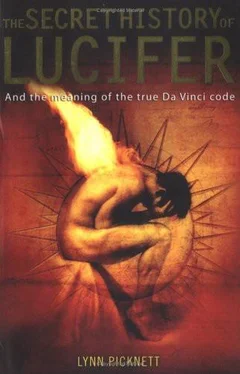There are other, considerably more offensive examples of this Johannite sub-text in Leonardo's works. In his unfinished Adoration of the Magi, the Virgin and child occupy the lower foreground, where they are honoured by the visit of the Wise Men, as the title indicates. Yet, like all the great Florentine heretic's works, it repays closer scrutiny. The worshippers adoring the Holy Family are hideous, so gaunt, ugly and ancient - with their shrunken eyes and skull-like heads - that they appear to be like ghouls or vampires from the grave clawing at Mary and Jesus. And of the three famed gifts, only frankincense and myrrh are being proffered: gold, symbol of sacred kingship and perfection, is missing.
A second group of worshippers occupy the top half of the picture, beyond the Virgin's head. These are in marked contrast to the `undead' around her and the infant Christ - vigorous, youthful, attractive, they appear to be adoring the roots of a tree. Bizarre though this may seem, there is a message here: the tree is a carob, traditionally associated in Catholic iconography with John the Baptist - and as if to reinforce the point, a young man raises the John gesture close to its trunk. Another man lurks at the bottom right of the picture, turning almost brutally away from Mary and Jesus. This is acknowledged to be a self-portrait of the artist, and here he is blasphemously turning his back on God incarnate and the Immaculate Conception. And as the model for Saint Jude in his Last Supper, Leonardo also has his back to Christ. There is a wry joke here - Jude is patron saint of lost causes!
There is considerably worse blasphemy in The Virgin of the Rocks (the Louvre version: the painting in London's National Gallery is less obviously heretical), which was originally commissioned by a religious organization, who certainly got more than they bargained for, although they seem not to have realized quite what they did get. The painting shows a scene from Church fable, in which the baby Jesus meets the equally infant John in Egypt specifically to confer on him the authority with which to baptize him in later life. The fact that to perform any rite on Jesus Christ implies greater authority than his had to be explained away in this cumbersome manner (although of course in the case of the anointing Magdalene the Gospel writers simply edited out her identity and made her act random, virtually meaningless).
The painting shows the Virgin apparently with her arm round John, who is kneeling submissively to Jesus, who in turn blesses him. Christ appears to be in the care of the archangel Uriel. Yet there is something wrong here: Uriel is traditionally the protector of John, not Jesus, and obviously Mary should be holding her son, not John. But suppose the children are with really their usual guardians, everything suddenly makes sense and Leonardo's fervent Johannitism shines through once again. For then it is John (now properly with Uriel) who is blessing Jesus (now with Mary), who in turn kneels submissively ...
Leonardo also made his feelings about Mary's status very clear. The reason this painting is called The Virgin of the Rocks is because almost the whole of the top half is given over to apparently random shapes of dark, looming stones. But nothing is truly random in Leonardo's works, especially when he has the opportunity to pour ridicule on Christ and his mother. For rearing up out of the rocks virtually out of the Virgin's head is a remarkable pair of testicles topped by a huge upright phallus - right to the skyline - complete with tumescent central vein and impudent spurt of weeds. Clearly, once seen in this light, The Virgin of the Rocks will never quite have that pious aura again. This astonishing interpolation was presumably intended to be a savage attack on the alleged virginal status of Mary the mother, possibly inspired by the organization that commissioned the painting - the Confraternity of the Immaculate Conception.
But why did Leonardo so clearly adore the Baptist, while despising Jesus and his mother? What is it about John that inspired so much devotion - and why should it be heretical?
The Baptist: behind the myth
It is curious that John the Baptist is not celebrated as the first Christian martyr - that honour fell to the young Saint Stephen. Even when John was arrested by Herod and then beheaded on the wishes of Herodias and her unnamed daughter, the New Testament is silent about whether he cited Jesus Christ as his inspiration and Saviour with his last breath. Nor are we told in whose name John baptized ...
This odd but implicit reticence on the part of John to acknowledge Jesus' superiority is dramatically at odds with the explicit scene in the New Testament where John apparently makes sense of his entire life by falling at Christ's feet, declaring him to be the chosen Lamb of God, whose sandals he is unworthy to untie. Jesus is baptized in the Jordan, and God appears in the form of a dove, announcing his Son's divinity. This is splendid, inspirational stuff, but unfortunately it is almost certainly complete and utter nonsense.
If John had really been so overcome at the very sight of Jesus, it was a passing phase, because not long afterwards, as he languished in jail he sent a message to him asking `Are you the one who was to come, or should we expect someone else?"' But while the scene at the side of the Jordan is enthusiastically read out from the world's pulpits, the clergy keep tactically silent on the matter of John's subsequent doubts.
In fact, we now know that although Jesus must have been baptized by John - because thousands flocked to join the movement to repent and be baptized - in reality there never could have been any of that rather sickening `Gosh, you're so wonderful and I'm so unworthy' declaimed by the Baptist. For it is now acknowledged that Jesus and John were rivals, and so were their respective cult members. In fact, despite the biblical depiction of John as a sort of mad desert hermit who enters the story briefly to bolster Jesus' image but apart from that hardly makes a wave, he and his movement were huge. The Baptist's following extended from Egypt, where he had his headquarters at the port of Alexandria, as far as Ephesus in Turkey. In fact, it might more properly be called a church. Indeed, its very existence startled Paul on his first visit to Ephesus and Corinth, especially when some of the Johannites told him they had never heard that John had prophesied the coming of any Messiah, let alone this Christ. It was Jesus' group that more closely resembled a cult, most probably a breakaway movement from the Johannites. And it was Jesus who was never mentioned in the only secular chronicles of the day, by the Romanized Jew Flavius Josephus in his Antiquities of the Jews, whereas the Baptist's celebrity is given a glowing report. In fact, there is now a rather gushing passage that celebrates Jesus in the Antiquities, but it was a medieval insertion by a monk, specifically invented to cover the embarrassing non-appearance of Christ.
Clearly, John would never have grovelled at Jesus' feet: the New Testament being really little more than propaganda on behalf of the triumphant Jesus sect, this was an audacious fabrication. But as the Gospel writers had no wish to waste too much effort on John or build him up in any way, they stopped short of actually making him a Christian martyr, or, even given his fulsome welcome to Jesus, any kind of Christian at all.
Yet they did go to some trouble in rewriting the Baptist, but unfortunately causing a lasting confusion in the process: scholars are now convinced that certain passages from the New Testament originated in Gospels dedicated to John, not Jesus at all. They have isolated, for example, the opening passage of the Gospel of John (although the name is probably a coincidence) as belonging to the `John literature'. And the Virgin Mary's famous hymn of praise to God when she discovers she is pregnant with Christ known as the Magnificat was originally Elizabeth's song - John the Baptist's mother. Similarly, Herod's massacre of the Innocents was originally intended to rid himself of the threat of a blue-blooded John growing up and challenging his authority (although even so it was only ever fictitious - no chronicler reported such an atrocity). In other words, the late firstcentury followers of Jesus took over the Baptist's gospels and basically just changed the name of the hero. But the Gospel of John is also the one about which it is claimed that the Magdalene was its author ...
Читать дальше












